MARIANI’S
Virtual Gourmet
July 15,
2018
NEWSLETTER
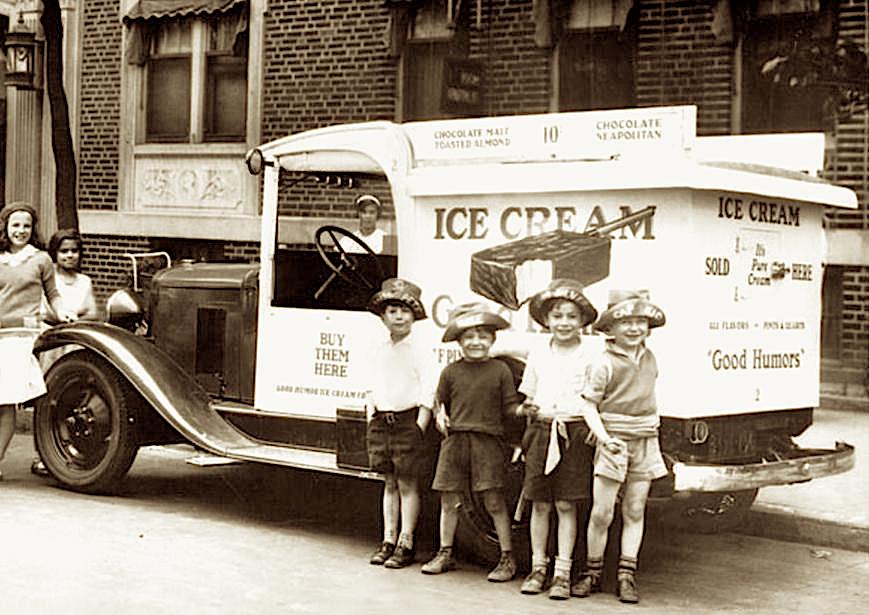
Good Humor
Ice Cream Truck, circa 1930
IN THIS ISSUE
BRUGES, BELGIUM
By John Mariani
NEW YORK CORNER
OKO
By John Mariani
NOTES FROM THE WINE CELLAR
SOME CAVEATS ABOUT
WINE AUCTIONS
By John Mariani
❖❖❖
BRUGES, BELGIUM
By John Mariani
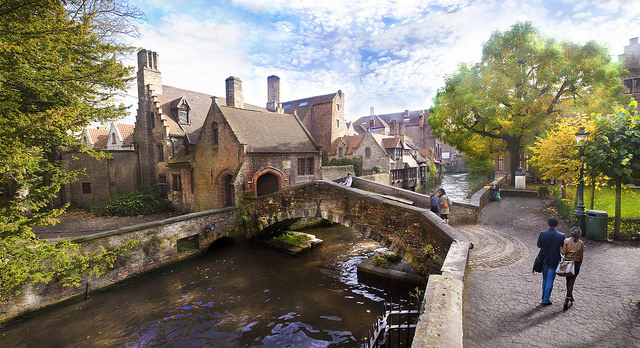
It
came as quite a surprise to me to find that
the Belgian city of Bruges is among the most
visited tourist destinations in
Europe. All
those people can’t
possibly have been tickled to visit by the
hilarious 2008 crime film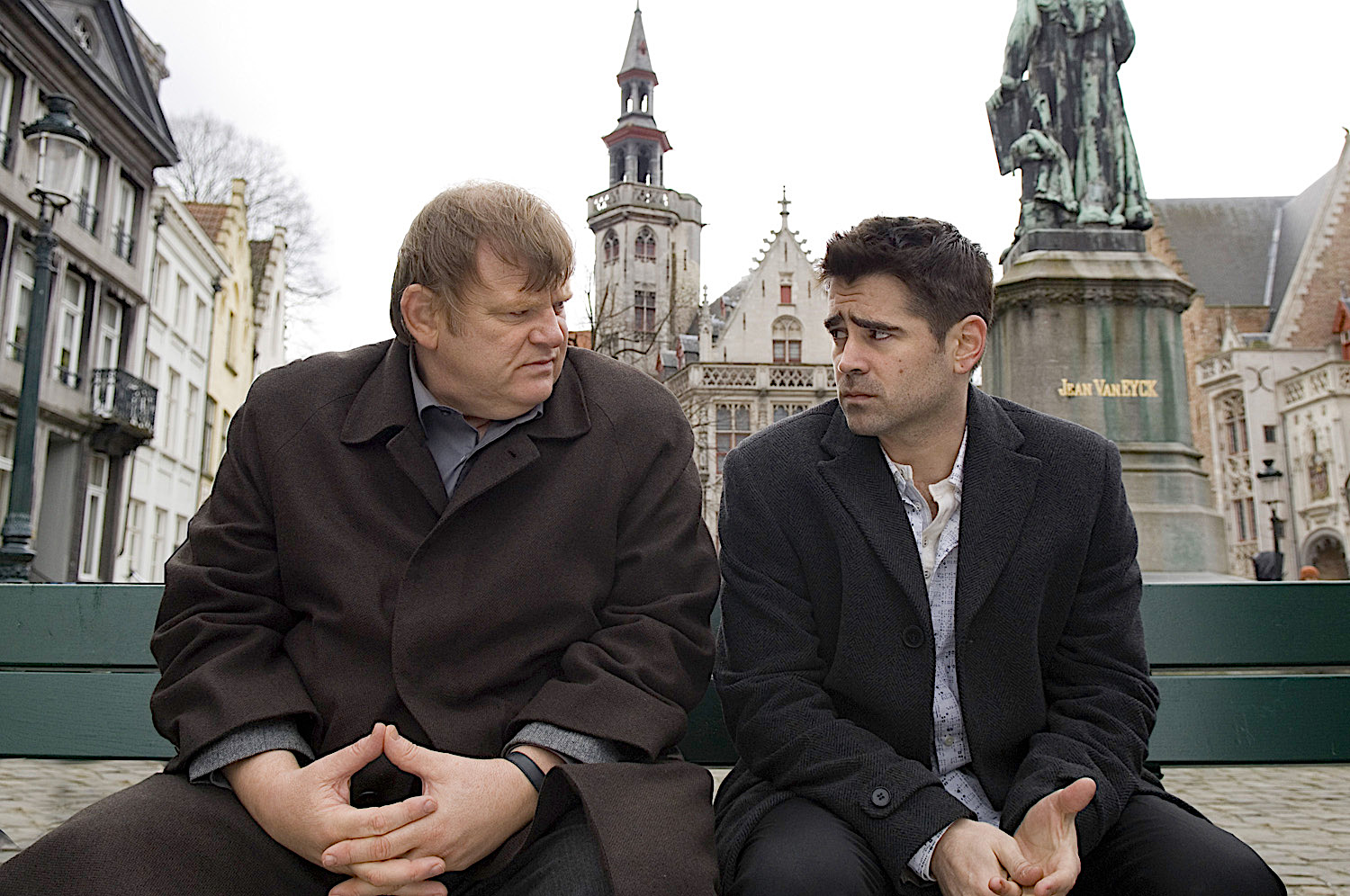 In Bruges,
in which two hapless Irish
hit men (Colin Farrell and Brendan Gleeson, left) are
sent to cool off after a bungled job to a
Belgian
city they’d never even heard of.
In Bruges,
in which two hapless Irish
hit men (Colin Farrell and Brendan Gleeson, left) are
sent to cool off after a bungled job to a
Belgian
city they’d never even heard of.
I suspect that’s true of many
people, but
there’s no question that the film made Bruges look
like an undiscovered gem, as
it was for me till I visited this spring. Of
course, it’s a gem that dates back
to a prehistoric coastal settlement, followed by
the usual Roman domination and
incursions by the Franks and Vikings.
Through times of boom and bust, Bruges has
always been a strategic port
town, and as of the 19th century became a tourist
destination for
wealthy French and British travelers. But it was
not until well after World War
II that the largely untouched medieval city again
became popular for tourists
around the world. Today you’re as likely to bump
into Chinese 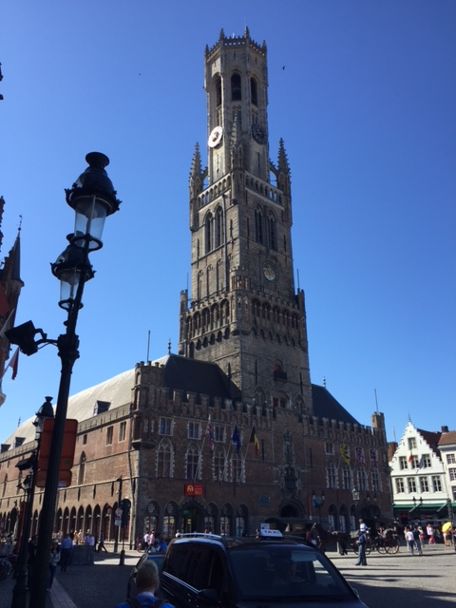 and
Japanese as
Americans and Europeans, and throughout the year
there are well-attended music
and arts festivals, including Jazz Brugge and the
Cinema Novo film festival that draw international
crowds.
and
Japanese as
Americans and Europeans, and throughout the year
there are well-attended music
and arts festivals, including Jazz Brugge and the
Cinema Novo film festival that draw international
crowds.
The inner city itself is only
1,000 acres in
size, with a population of just 20,000 (Ghent and
Antwerp are much larger), so
that you can walk around it in a couple of hours.
But a 40-minute cruise among
the canals that cause Bruges to be called the
“Venice of the North” is a wonderfully
leisurely way to see so much more of the
surrounding neighborhoods.
The
large Gran Markt of Bruges,
dominated by the beautiful city hall and bell
tower (right),
is surrounded by buildings
of different periods, including the 19th century
Neo-Gothic Provincial
Hoff. There
you’ll also find the
quirky but delightful Frites Museum, dedicated to
the history and culture of
Belgian’s fried potatoes, a Chocolate Museum, a
Lamp Museum, a Beer Museum and
even a Torture Museum with its own gruesome
allure.
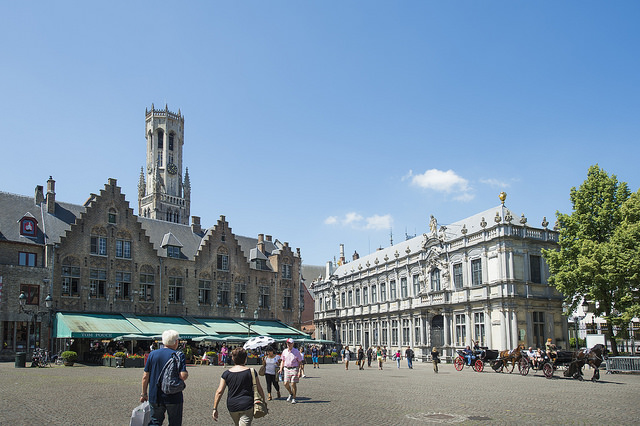 The
exquisite Stadhuis Town Hall and Law
Courts (now the Tourist Office) is set within the
equally spacious Burg square
nearby the Market.
From these open
public spaces, the side streets lead down to the
Dijver Canal, where the city’s
fine art Groeninge Museum is located, with works
by Jan van Eyck and other
Flemish masters. There is also a museum specially
devoted to the Hans
Memling, as well as a diamond museum and much
else, so, rather than take it all in on a
weekend, return visits would be requisite to see
just how rich a history and
the architectural beauty Bruges possesses.
The
exquisite Stadhuis Town Hall and Law
Courts (now the Tourist Office) is set within the
equally spacious Burg square
nearby the Market.
From these open
public spaces, the side streets lead down to the
Dijver Canal, where the city’s
fine art Groeninge Museum is located, with works
by Jan van Eyck and other
Flemish masters. There is also a museum specially
devoted to the Hans
Memling, as well as a diamond museum and much
else, so, rather than take it all in on a
weekend, return visits would be requisite to see
just how rich a history and
the architectural beauty Bruges possesses.
The 13th century Church of Our
Lady, stunningly
restored to a bright, glowing luster, has the
tallest spire (367 feet)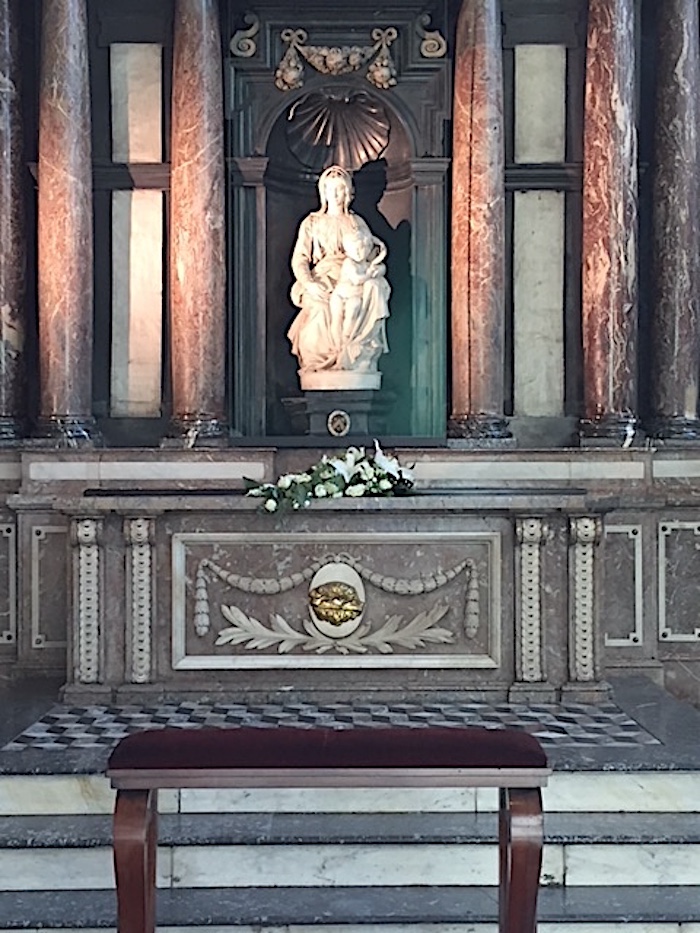 in
Belgium and one of the rarest works of art in the
world—a sculpture of Virgin
and Child by Michelangelo (right), along
with a stunning triptych of Christ’s
crucifixion by Rubens.
in
Belgium and one of the rarest works of art in the
world—a sculpture of Virgin
and Child by Michelangelo (right), along
with a stunning triptych of Christ’s
crucifixion by Rubens.
At the moment Bruges is alive
with a citywide
event called the Triennial—a celebration of a city
“quite literally
surrounded by water, but also liquid in
a metaphorical sense, as a
city in constant and flowing artistic
movement, sometimes
storm-tossed, sometimes peaceful and calm”—at
which fifteen celebrated
global artists and architects have placed
huge installations under the theme “Liquid
City” on or about its canals.
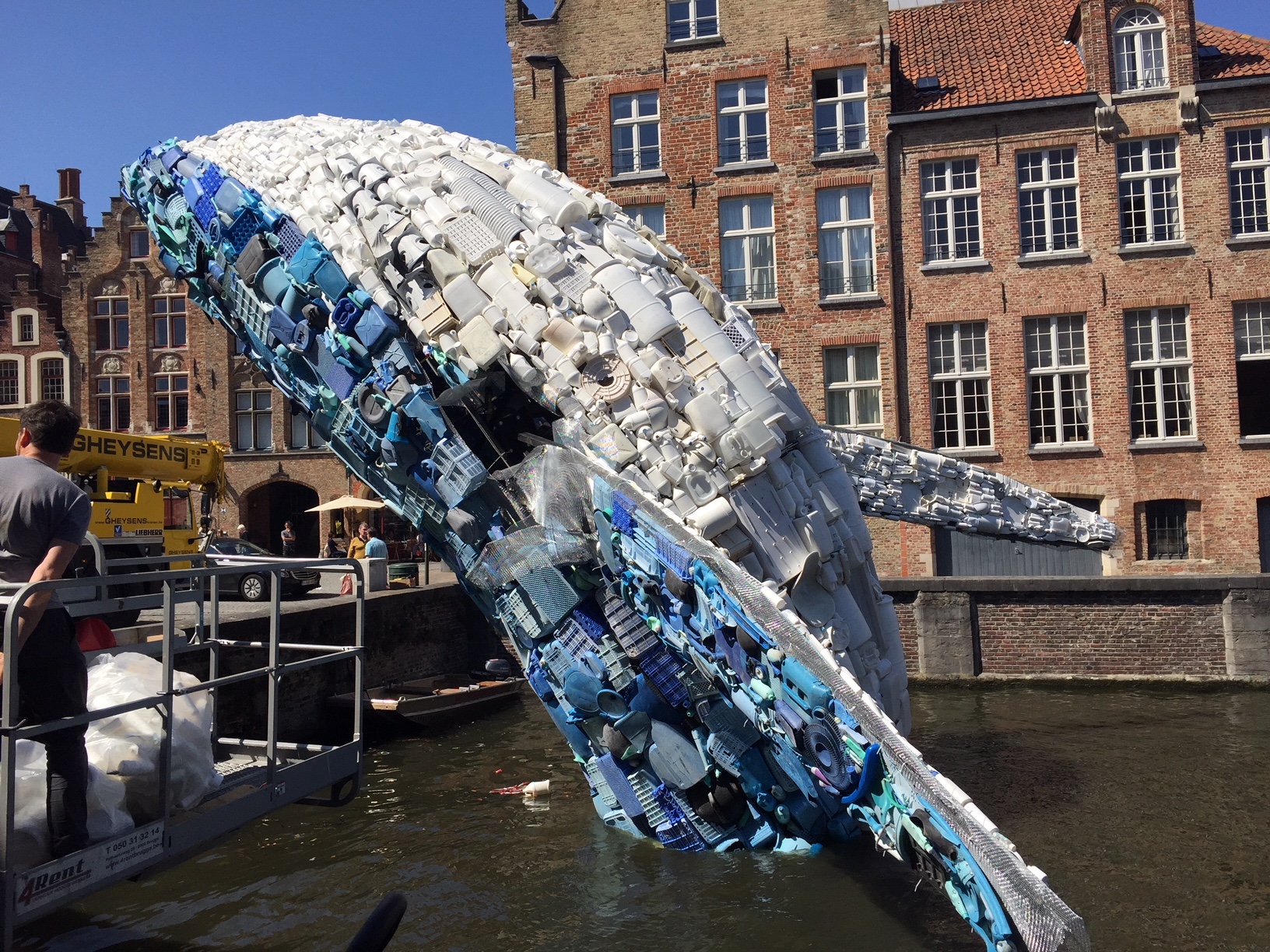 In
one location, where there is a longstanding statue
of Jan Van Eyck, StudioKCA,
from Brooklyn, has placed the huge “Bruges Whale”
leaping from the water. Made of the kind of plastic
refuse that
now clogs the world’s oceans, all of it collected
in just six months, it is a
dramatic comment on the global impact of such
detritus both on the ecology and
the marine population. Two weeks after its
installation, a sperm whale that had
ingested dozens of just such plastic objects
washed up on the beach in Spain,
showing just how advanced this scourge is.
In
one location, where there is a longstanding statue
of Jan Van Eyck, StudioKCA,
from Brooklyn, has placed the huge “Bruges Whale”
leaping from the water. Made of the kind of plastic
refuse that
now clogs the world’s oceans, all of it collected
in just six months, it is a
dramatic comment on the global impact of such
detritus both on the ecology and
the marine population. Two weeks after its
installation, a sperm whale that had
ingested dozens of just such plastic objects
washed up on the beach in Spain,
showing just how advanced this scourge is.
Other installations can be
walked through, like
the pavilion of a surf wave done in fuchsia and
neon yellow. Another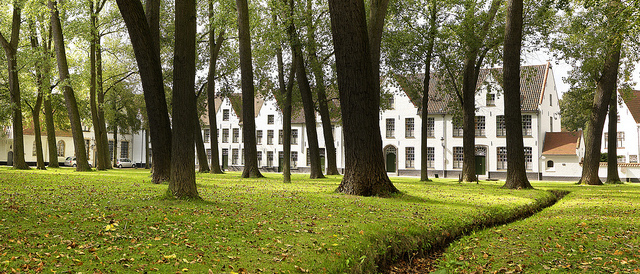 is a
“Floating School” by a group called NLE out of
Nigeria set near the beautiful
Minnewater, a Benedictine nunnery (right).
The Triennial runs through Sept. 16. Tours
of all the artworks are
available.
is a
“Floating School” by a group called NLE out of
Nigeria set near the beautiful
Minnewater, a Benedictine nunnery (right).
The Triennial runs through Sept. 16. Tours
of all the artworks are
available.
The Love
Brugge City Card, available for 48 or
72 hours, offers free access to two dozen museums
and attractions, a minibus tour
of the city or cruise through its canals, and
discounts on events, parking and
bike rentals.
Also, ask at your
hotel for the free “Discoverbruges” discount card
to receive a discount at
numerous attractions and shops in Bruges and
surroundings.
❖❖❖
By John Mariani
6 Wilton Road
Westport, CT
203-557-8404

We live at a time when
media-craving chefs
reject simplicity for sheer elaboration, so it
is good to remind them that
sushi is the easiest thing in the world to screw
up and the most difficult to
make one’s own.
As a moderate
purist, I like sushi largely untainted and
require first that the fish be of
both unstinting freshness 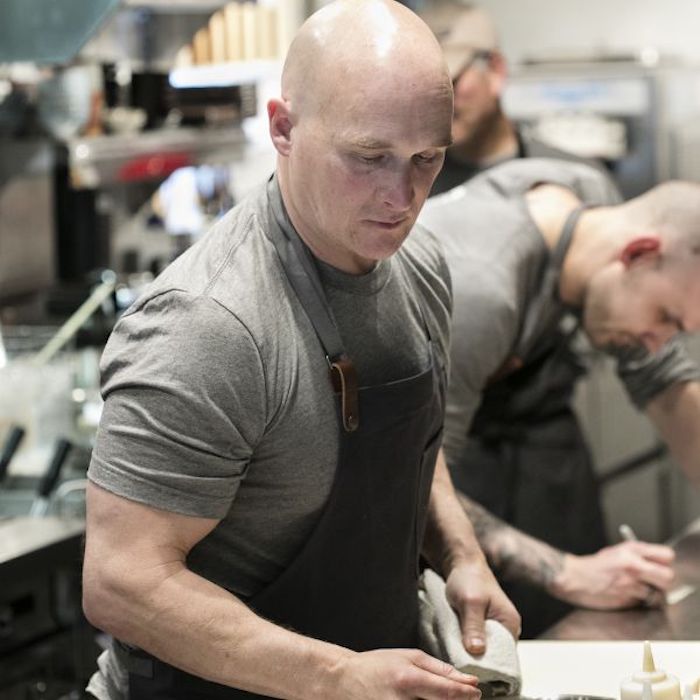 and identifiable as a
species, so that everything on
the plate doesn’t taste the same.
Tuna should not taste like halibut and
mackerel should not taste like
salmon. After
that, the rice is of
equally great importance, its kind, its texture
and its temperature. Within those parameters I
am most happy
at a sushi bar.
and identifiable as a
species, so that everything on
the plate doesn’t taste the same.
Tuna should not taste like halibut and
mackerel should not taste like
salmon. After
that, the rice is of
equally great importance, its kind, its texture
and its temperature. Within those parameters I
am most happy
at a sushi bar.
Thus, the arrival in Westport,
Connecticut, of a
Japanese restaurant so special— where the rest of
the menu is at least as enticing
as the sushi, which is itself outstanding—makes
OKO the best new restaurant I
have dined in so far in 2018. The
fact that it is run by a non-Japanese chef—born
and raised in the New York
suburbs—whose nearby restaurant The Cottage is
exemplary for its modern
American food may seem all the more surprising,
except that Brian Lewis (left) has
proven his ability to combine the finest culinary
traditions with his own
restrained sense of innovation. At
OKO he has so obviously thought through every dish
to be a personal expression
that I could imagine him opening up a taco stand
with his own sense of style
and creativity.
I first enjoyed Lewis’s cooking
at the Bedford
Post Inn, then at his own place, Elm, in nearby
New Canaan, where he was
already showing a talent for Asian flavors and
techniques he furthered at The
Cottage. 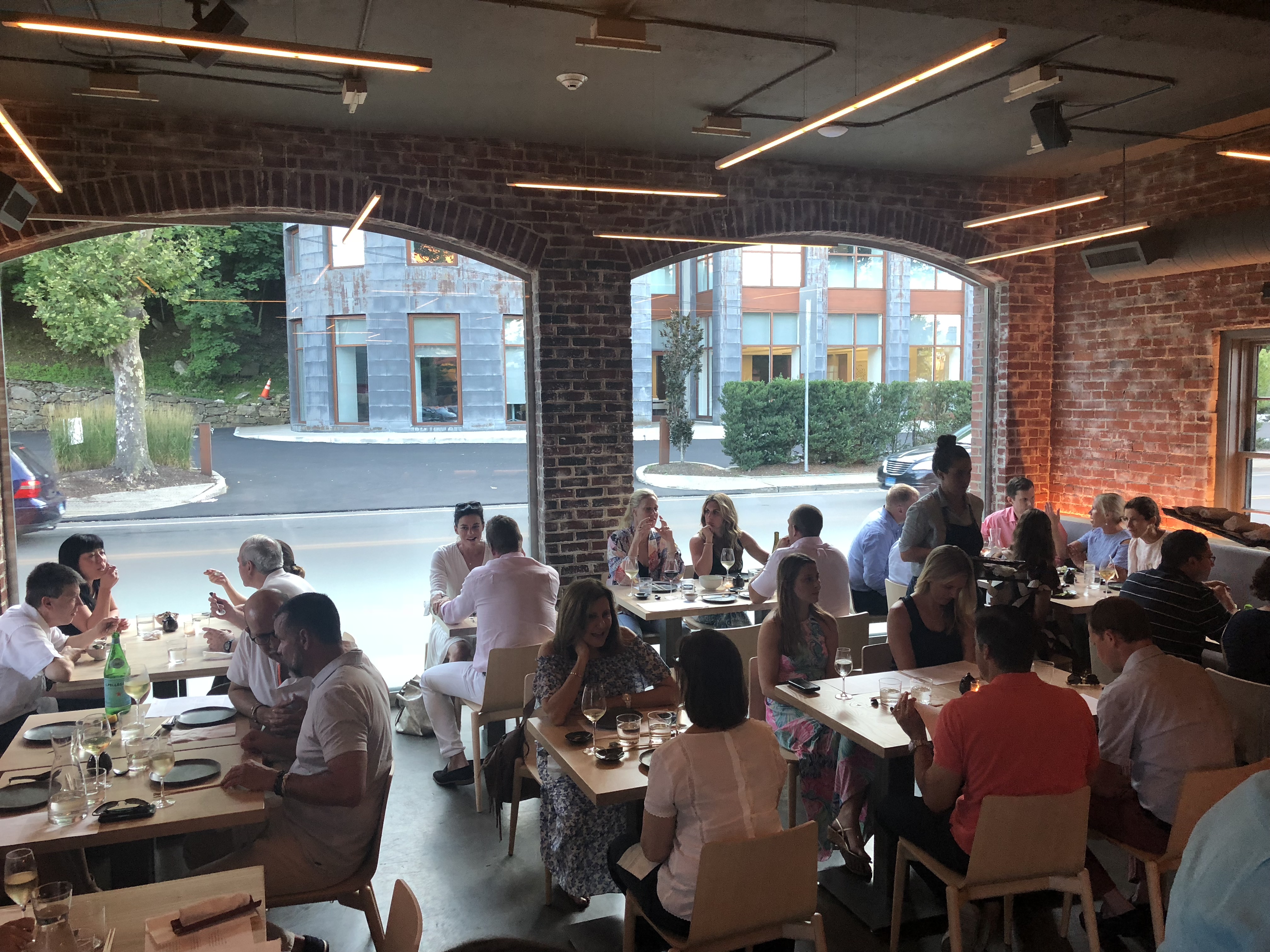
OKO is located within a
historic brick building
in Westport known as the Vigilant Hose Company,
and with its scrubbed red brick
walls, big windows, fluorescent lighting, bare
wooden tables and big open bar,
it’s almost as loud as if a fire truck was revving
up to leave. (Lewis told me
sound-proofing is on the way.)
The nigiri sushi section is
extensive (the
chef’s selection, five for $25, ten for $45, is
the way to go; otherwise,
$4-$10 piece),
and most is not
what you might expect if you’re used to seeing
only a slab of fish atop a
finger of rice. For one thing, as at the best
sushi bars in Japan and New York,
Lewis assesses the correct temperature for an item
and, accordingly, may give it
a quick blast with a hand-held blowtorch. Thus, hamachi is flavored with a scallion
aïoli and gomashio,
slowly roasted
garlic and sesame.
Akami
tuna, from the leaner part of the
fish, is classically blanched and then marinated
for up to two days, served with
a nikiri
shoyu of caramelized maple
syrup, puffed quinoa and avocado-yuzu puree.
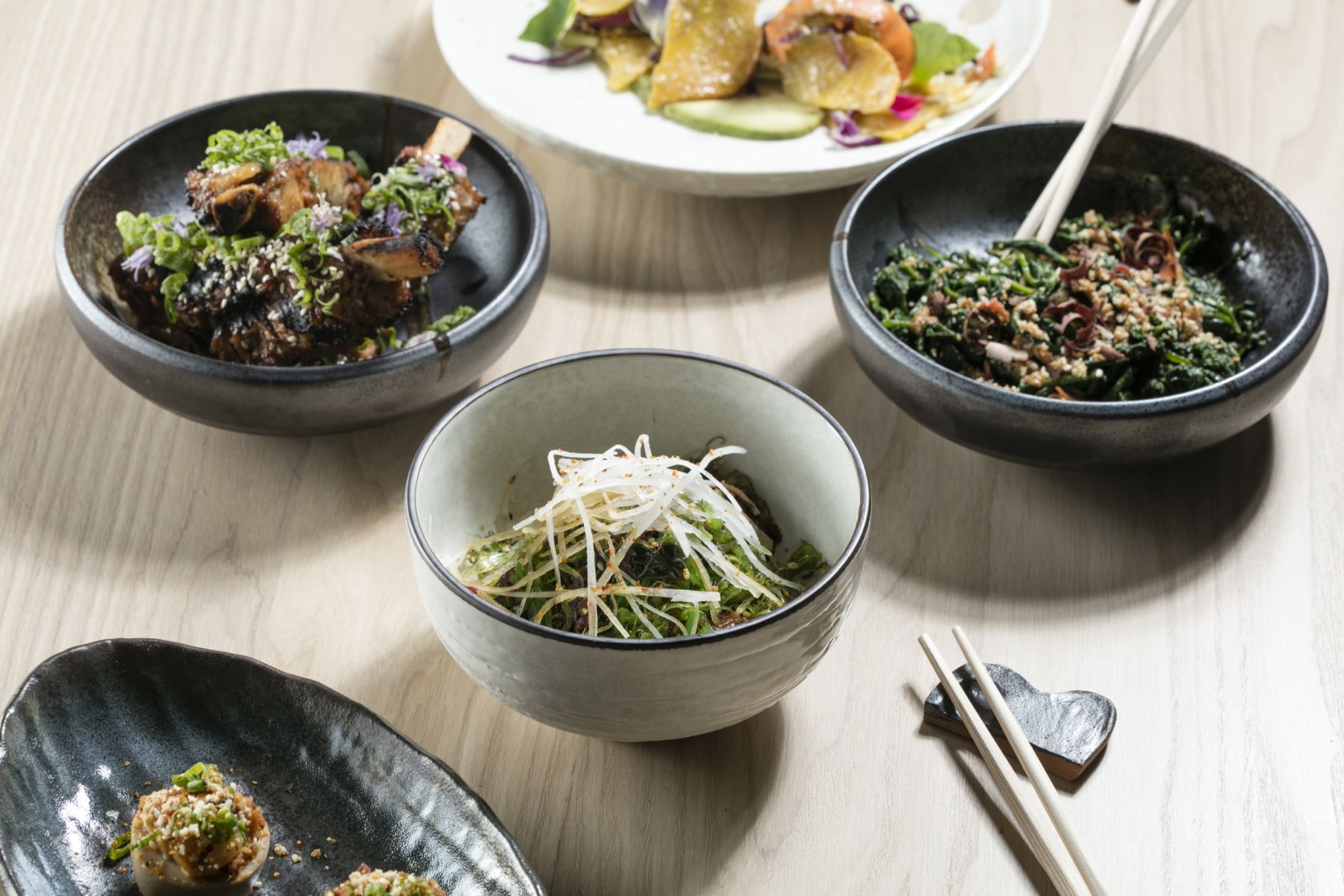 Wild King
salmon is paired with yuzu and
finger lime, while morels are
braised in sake butter and served over a Japanese
omelet flavored with dashi, mirin
and soy. And Atlantic
squid is
thinly scored to absorb
red kimchi
juices and a touch of sichimi
togarashi spices.
Wild King
salmon is paired with yuzu and
finger lime, while morels are
braised in sake butter and served over a Japanese
omelet flavored with dashi, mirin
and soy. And Atlantic
squid is
thinly scored to absorb
red kimchi
juices and a touch of sichimi
togarashi spices.
There were many more wonderful sushi
options,
but let me not miss telling you of a starter of chilled
King
crab salad, tomato
dashi, avocado, wasabi and white
soy ($17),
and a razor clam and cauliflower with smoked trout
roe and dashi ponzu ($4).
Among the cold and sashimi
dishes I
marveled at the complex flavors of golden snapper
with smoky roasted salt and
red yuzu
koshu ($9) and marvelous kabiyaki-glazed
sea eel, with aromatic
sancho pepper ($6) that Lewis brought back from
Kyoto. Mackerel
shime saba had a little pickled
jalapeño ($6). Sweet shrimp in a
rich garlic-brown butter soy took a hit from that
blowtorch to meld the flavors
($8). Foie gras with cherry yuzu took
on a sweet side from kosho
maple soy
($10) and was spiced with five-spice powder and junmai daiginjo sake made from pure
rice and water only. I’m not
sure I believe in umami, but if it is a fifth
flavor, Lewis’s food has it.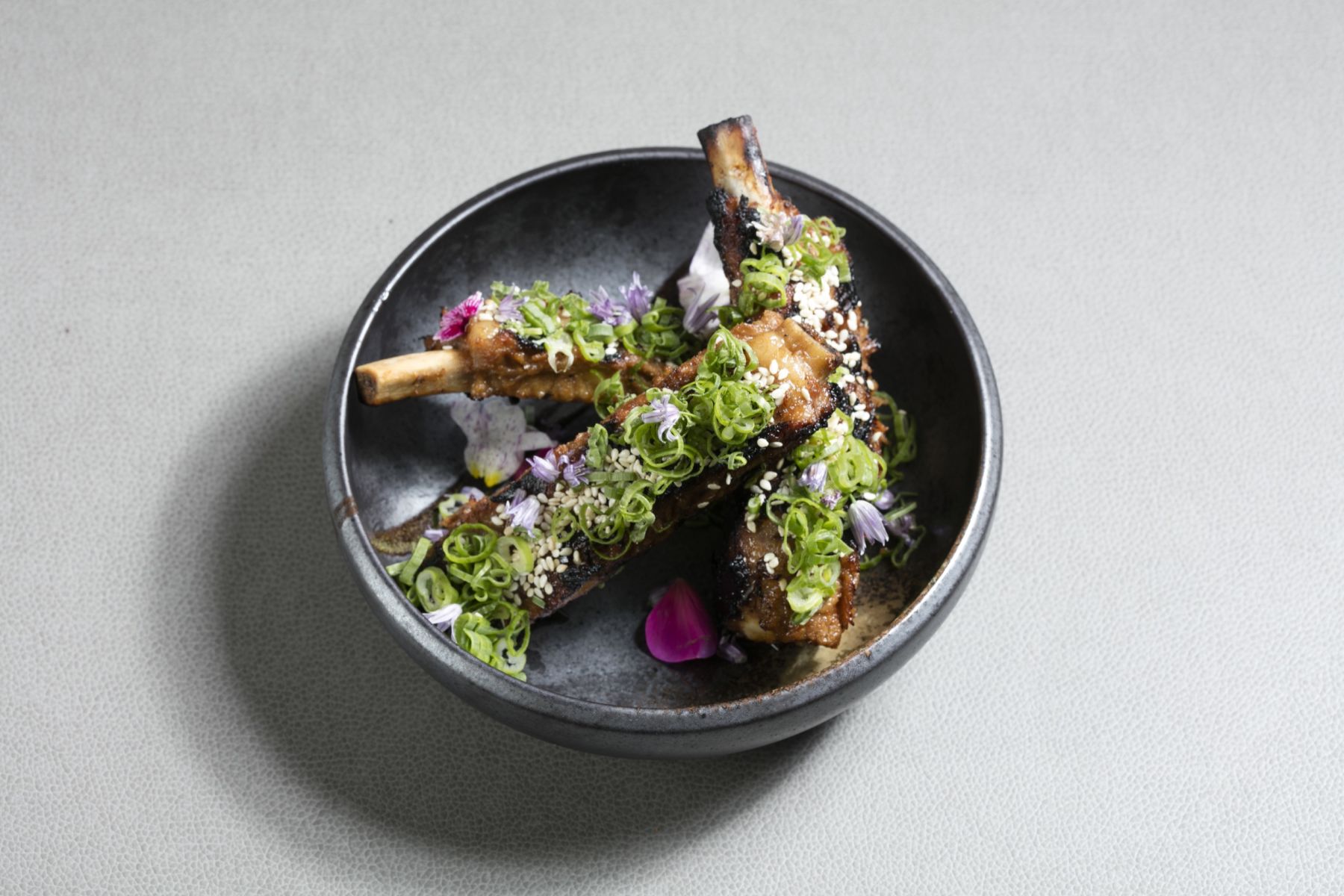
Foie gras
also provided the filling for succulent gyoza dumplings,
glazed with umeboshi
pickled fruits and duck jus
($14). Buttered King crab legs
($19) were grilled over coals, basted in sudachi
citrus fruit and chili butter, then finished with
a mayonnaise given the torch
treatment.
Perhaps the finest of all three
dishes I had that night was a perfect seared sea
scallop roasted on the
teppanyaki grill, served with hot red kimchi
juices emulsified with sake butter, squid caramel
and a salad of scallion,
daikon and carrots ($6), followed by sticky ribs (right) with
smoked maple, gochujang
chili paste and sesame crunch
($17).
The least interesting of the
dishes
were the tempura items ($5 to $18) of beans,
mushrooms, eggplant and other
vegetables that all tasted pretty much the same
within a too-thin, unseasoned
gluten-free batter.
On the assumption that no one
really expects great desserts in a Japanese
restaurant, Lewis simply serves up
delightful soft serve ice cream to finish ($5),
but all are done with flair,
like ginger blueberry jam,
brown butter almonds,
butterscotch, matcha twist, sesame popcorn and sweet adzuki
bean.
I had
expected Lewis would put a
lot of thought into the beverages, so I was happy
to see such an array of
cocktails, sakes, wines, beer and teas—not a huge
list, but a well chosen one.
OKO is a restaurant of
substance
and personality, something wholly new in the
suburbs of New York and
competitive with the best in Manhattan, where
you’ve got to be very good to
create a reputation. That Lewis
can do as he does and still charge very reasonable
prices is all the more
amazing. If
there was ever a reason
to drive up to Connecticut to eat, OKO—about 75
minutes from Manhattan—is it.
❖❖❖
SOME CAVEATS ABOUT WINE AUCTIONS
By John Mariani
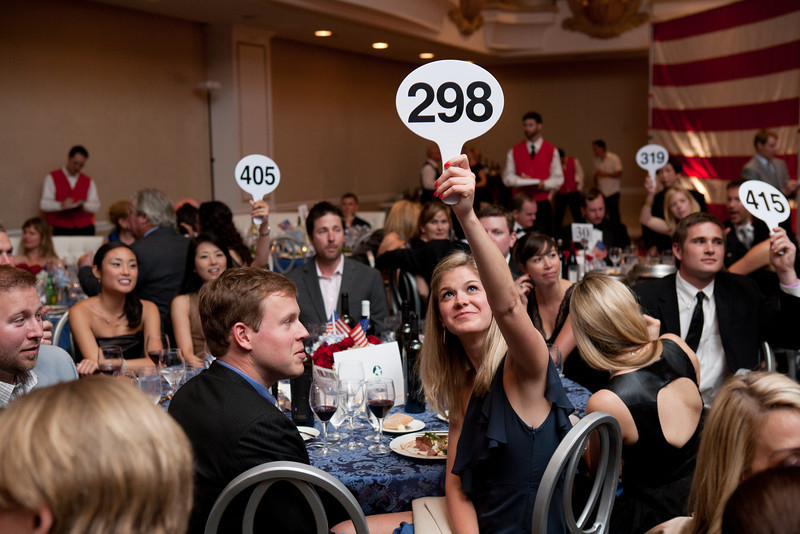
If
reports
about wine fraud in major auction houses are
making you queasy about what you
really have in your cellar, there are a few ways
to minimize your risk in the
future.
 First
of all,
despite reports in the Wall Street
Journal and elsewhere that New York
auctioneers have allegedly sold
counterfeit wines and inauthentic vintages, a
reputable auction house or fine
wine store is still the most sensible way to buy
rare wines, because those
institutions have so much to lose if wrong. In
2017 auction totals in the U.S., U.K. and Hong Kong
markets, plus online sales,
rose 12.7 percent to $381.7 million, up from $338.7
million
in 2016, although the peak was in 2011, with
global wine auction sales at $478 million.
First
of all,
despite reports in the Wall Street
Journal and elsewhere that New York
auctioneers have allegedly sold
counterfeit wines and inauthentic vintages, a
reputable auction house or fine
wine store is still the most sensible way to buy
rare wines, because those
institutions have so much to lose if wrong. In
2017 auction totals in the U.S., U.K. and Hong Kong
markets, plus online sales,
rose 12.7 percent to $381.7 million, up from $338.7
million
in 2016, although the peak was in 2011, with
global wine auction sales at $478 million.
“Auction
houses
vet their wines very carefully,” Peter Meltzer,
author of Keys to the Cellar:
Strategies and Secrets
of Wine Collecting, said in a phone
interview. “I would not be overly
worried. Also, the night before or the day of the
auction there is usually a
pre-sale tasting where for $50 to $100 you can
sample many of the wines that
will be up for bid. They are also a good way to
meet and connect with other
collectors who might have more experience.”
The younger the
wines, the less probability there is for fraud,
even if a single bottle, like a
Romanée-Conti from a recent vintage, may cost well
over $1,000. Fraud occurs
mostly with older, rare vintages and, especially,
with large format bottles
called magnums (two ordinary bottles), jereboams
(six), methuselahs (eight) and
nebuchadnezzars (twenty), of which very few are
made.
So-called "trophy wines" are ripe for
forging, for it is the very rare
wines that collectors crave, like 1945
Mouton-Rothschild, 1947 and 1961 Pétrus,
and 1921 and 1967 Chȃteau d’Yquem, so they are the
ones most likely to be
faked, because they bring so much money. Nobody
fakes a wine from, say, 2010. And most of the time
the buyer never drinks the wine he buys, saving it
either as a trophy or for future sale.
The best advice
for a neophyte wine collector is to spend years
building a relationship with a
fine wine store in order to gain experience. A
store like London’s famous
Justerini & Brooks Wine Merchants, which
opened in
1749 and now has more than 2,000 active accounts,
including the royal family,
stocks its wines in impeccably maintained cellars,
and the company never buys
at auction, because they cannot be sure of the
provenance.
The
London-based MARC Fine Wines stocks more than
120,000 wines for sale 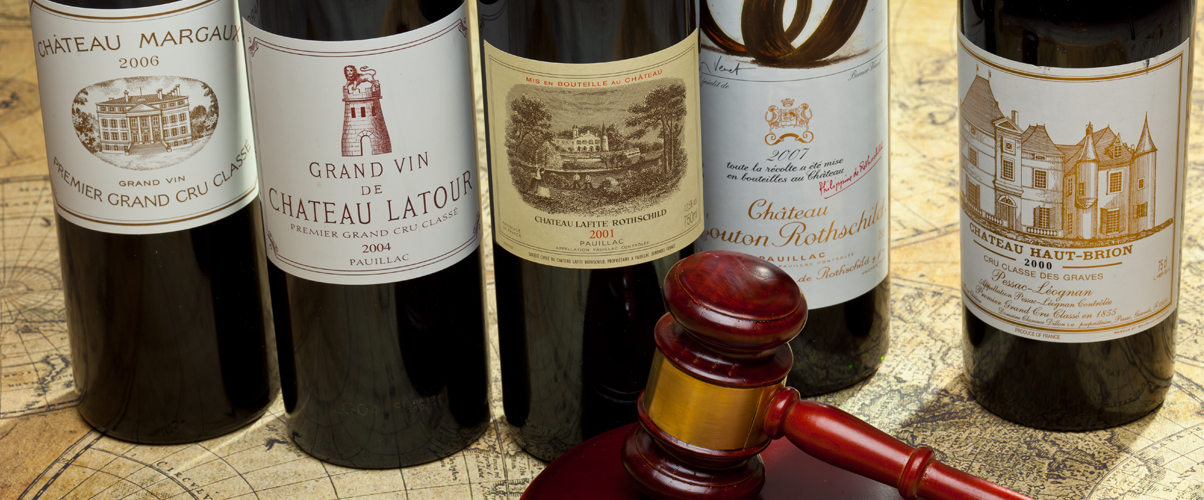 to the
trade and private collectors and will buy from
auction houses and private
cellars. Provenance, which is listed in the
auction catalogs, counts: If the sale of a ’61 or ’59
Bordeaux is from the chȃteau
itself, you can be sure it’s the real thing.
Auction experts may call the chȃteau
to ask about a particular bottle, if it seems in
some way suspicious.
to the
trade and private collectors and will buy from
auction houses and private
cellars. Provenance, which is listed in the
auction catalogs, counts: If the sale of a ’61 or ’59
Bordeaux is from the chȃteau
itself, you can be sure it’s the real thing.
Auction experts may call the chȃteau
to ask about a particular bottle, if it seems in
some way suspicious.
There may
be telltale clues, like the weight of the bottle,
the color of the wine (the
older the wine is, the lighter the color may be),
the condition of the capsule,
and the identifying marks on the label.
The most
targeted wine for fraud is Chȃteau Pétrus, whose
bottles used before 1982 did not
have identifying marks.
Obviously, not
everyone can be on a first-name basis with a
château, but many châteaus in both
Bordeaux and Burgundy, as well as in California,
are open to the public and may
offer “Library Selections” of older vintages that
have never left the estate’s
cellars. It is also a good idea to buy
“en
primeur” futures, with
certified proof-of-purchase from the winery
itself.
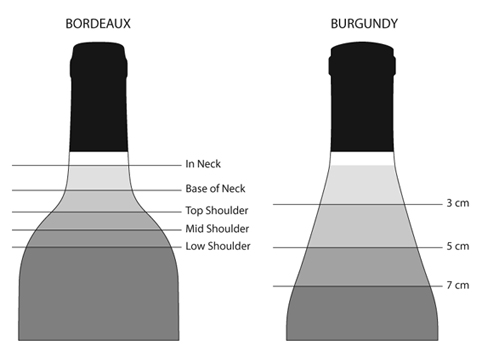 If you are interested
in buying at auction, certain telltale signs can
be gleaned from looking at the
label. Obviously,
an older wine’s
label should show some age, but the gap between
the wine in the neck and the
lip of the bottle—called ullage—which indicates a
degree of oxygen entering the
neck, can be telling. A very old
bottle will have more ullage than a recent vintage
(left).
Still, some collectors will
pay the chateau itself to open their wines and top
them off with a little of
the same vintage and then recork the bottle. Indeed, a few chateau
technicians even make the rounds in
London and New York to perform such a safeguard.
If you are interested
in buying at auction, certain telltale signs can
be gleaned from looking at the
label. Obviously,
an older wine’s
label should show some age, but the gap between
the wine in the neck and the
lip of the bottle—called ullage—which indicates a
degree of oxygen entering the
neck, can be telling. A very old
bottle will have more ullage than a recent vintage
(left).
Still, some collectors will
pay the chateau itself to open their wines and top
them off with a little of
the same vintage and then recork the bottle. Indeed, a few chateau
technicians even make the rounds in
London and New York to perform such a safeguard.
The corks
themselves will also have the date of the vintage
on them and show considerable
age, though laser printers these days can fake
that too. At auction a lot’s
provenance will be described, commenting on prior
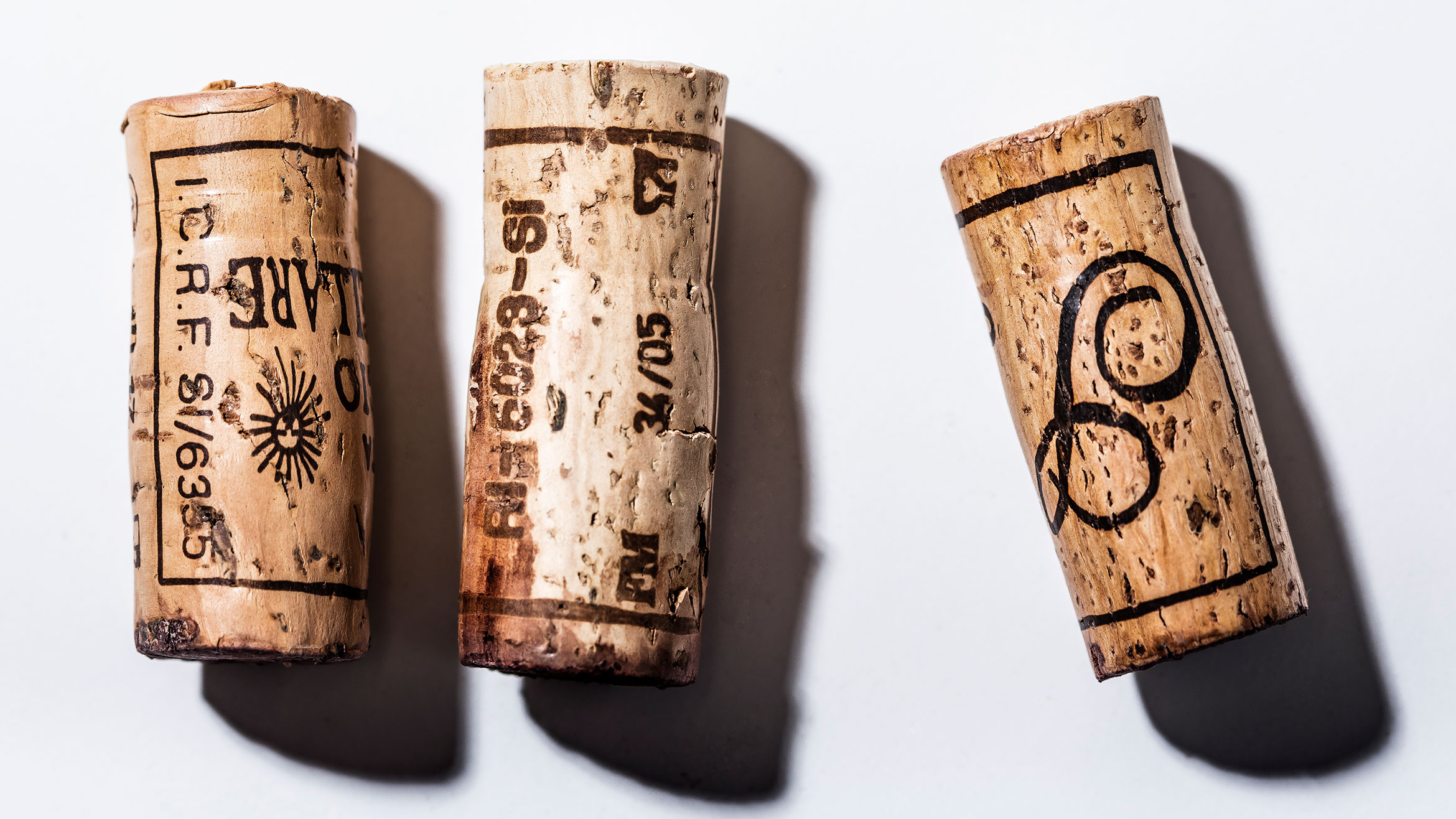 storage conditions and
whether the wine has come from a winery or a
single seller. One might also look
to see if a wine is packed “OWC”—in its “original
wooden case”—which may
actually increase the bidding price for such wine.
storage conditions and
whether the wine has come from a winery or a
single seller. One might also look
to see if a wine is packed “OWC”—in its “original
wooden case”—which may
actually increase the bidding price for such wine.
As in everything in life,
timing is important. When the 2008 recession hit
I decided to auction off some of my rare wines I
knew I'd probably never drink. But the market
was then so depressed that I made far less than
I'd imagined, even though my lot contained
Lafite-Rothschild, Pétrus and the California
cult wine of the day, Screaming Eagle.
In the end,
however, wine collectors should be wine drinkers.
“The best way to find a fake
is to open a bottle of the wine you’ve bought,”
says Meltzer. “If you’re
suspicious of it, you can bring it back to the
seller and have it tasted or
tested.” But be aware that auction houses sell
their wines “as is,” which
protects them more against spoiled wine than
fakes.
❖❖❖
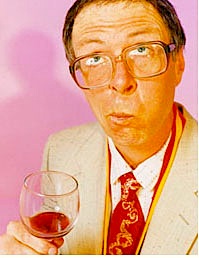
MOST EGREGIOUSLY SILLY
WINESPEAK OF THE MONTH
"Snappy
acidity and a salinity structure for this
aromatic white, light body, which offers a nice
mix of peach skin, Meyer lemon peel and pink
grapefruit sorbet flavors. Drink now until 2020.
"--Wine
Spectator (July, 2018).
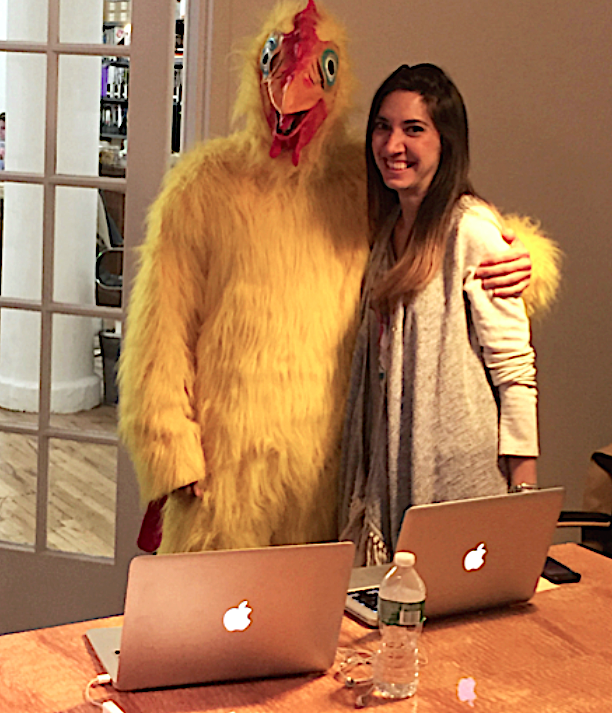
MEANING ONE OF THEM WILL LIKELY BE HEN-PECKED
Data scientists at NationalToday.com asked 1,000 Americans
how they feel about fried chicken, finding that: 95%
of Americans say they like fried chicken, 6% say they eat fried chicken
every day and 16%
going as far to say they would marry one.
Wine
Column Sponsored by Banfi Vintners
SANGIOVESE
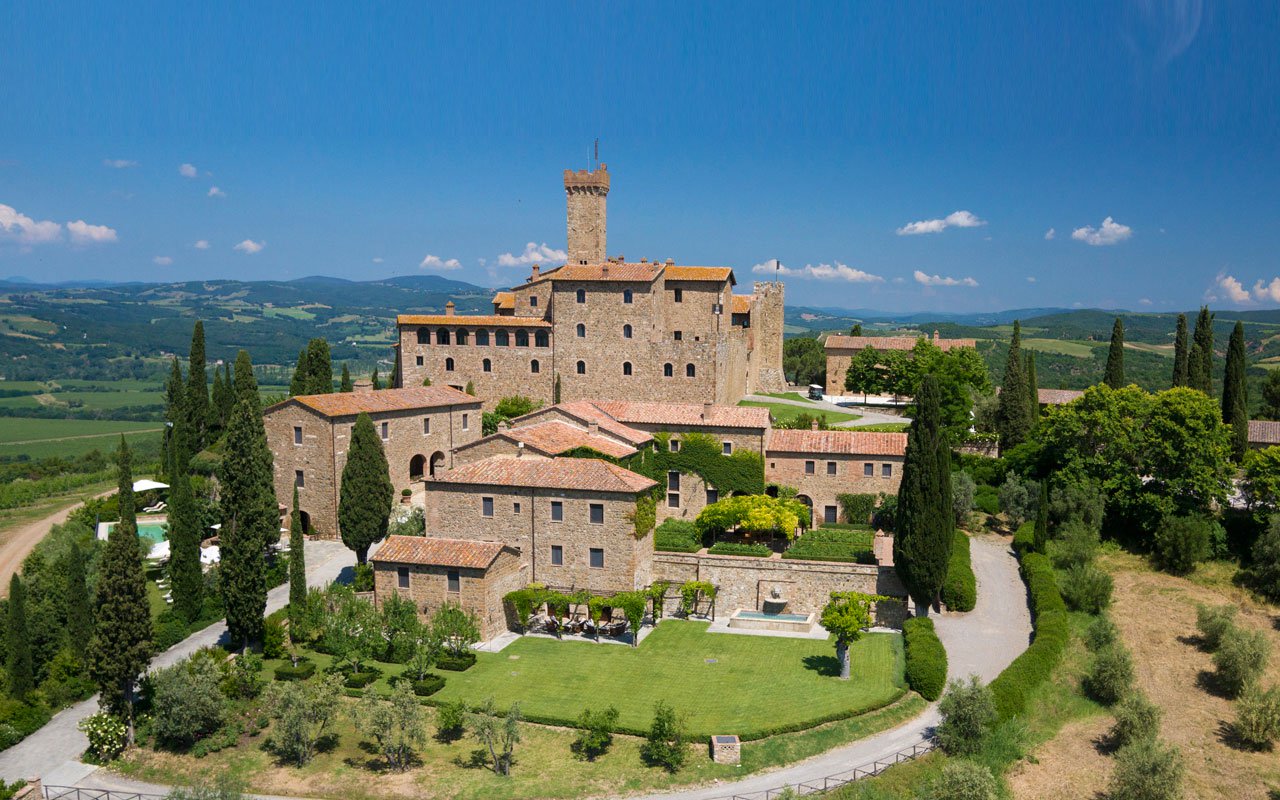 Wine is a joy year-round but
in cooler weather one
grape varietal has really taken center stage in
my daily activities – that most Italian of
grapes, Sangiovese, and its ultimate expression
– Brunello di Montalcino.
Wine is a joy year-round but
in cooler weather one
grape varietal has really taken center stage in
my daily activities – that most Italian of
grapes, Sangiovese, and its ultimate expression
– Brunello di Montalcino.
From mid-September through mid-October,
the Sangiovese grown for our various styles of red
wines are be harvested, culminating with the top
selection for Brunello di Montalcino.
Second, cooler weather here means
it is time to start enjoying more red wines and
especially Sangiovese based wines. That
includes Banfi’s cru of Brunello, Poggio alle Mura,
literally the cream of the crop of our Sangiovese
vineyards. Alongside our Poggio alle Mura Brunello di
Montalcino, this year we introduced two more wines
from the cru Poggio alle Mura – a Rosso di Montalcino
and a Riserva of Brunello. Rosso is sort of like the
younger brother of Brunello, also made from 100%
Sangiovese grapes but usually a selection from younger
vines and the wine is aged only two years compared to
the four required for Brunello. The
Riserva, on the other hand, is an even more selective
harvest of Sangiovese, and ages for an additional year
before release.
What is so special about this cru
Poggio alle Mura?
Well, it is the result our over 30 years of
ongoing research at my family’s vineyard estate,
Castello Banfi.
When we first began planting our vines there in
the late 1970s studies from the University of Bordeaux
indicated which strains of many varietals we should
plant, based on the soil type and microclimate of each
vineyard. But
when it came to the region’s native Sangiovese, there
was only local lore, no scientific research. So we took
it upon ourselves to figure out this vine, and set off
on three decades of incredibly detailed research.
We started
with 600 apparent variations on Sangiovese, because it
is so susceptible to variations in weather and soil,
and narrowed that down to 160 truly genetically
different clones.
We planted a vineyard with two rows of each
type, made wine from each of them, and charted the
differences – remember, you only get one chance a year
to make wine, so this took time.
It took about ten years to get some
concrete results, though we continue to experiment
today and always will – you never stop learning in
science and nature!
Once we determined which were the best,
complementary clones that could be planted together to
make the best Brunello, we chose to plant them in what
we determined to be the optimal vineyard sites. Coincidentally,
the best soils and climate conditions are in the
slopes surrounding the medieval fortress today known
as Castello Banfi, known since Etruscan times as
Poggio alle Mura – the walled hilltop. Hence the
name of our most special “cru” of Brunello,
representing a synthesis between tradition and
innovation.
Though the focus of this study was
our Brunello, all of our Sangiovese-based wines,
including the super Tuscans SummuS, Cum Laude, and
Centine, benefitted from this work. And that’s
the third reason for celebrating Sangiovese this
month, for the range of wonderful reds that usher us
into autumn! One
wine in particular was inspired by our research – the
BelnerO, a Sangiovese dominant blend with what I like
to call a kiss of Cabernet and a whisper of Merlot. We grow the
grapes a little differently for BelnerO than for
Brunello, make the wine with less oak aging and
released it earlier from the winery, providing a
counterpoint to Brunello and a lovely terroir-driven
wine in its own right.
If you
know Italians, you know that by nature we are
multi-faceted, varying in mood, and always passionate. As a
nation, we span from the hot sunny beaches of Sicily
near the African coast to the rugged mountains and
Alpine ski slopes of Trentino-Alto Adige in the north. Sangiovese
is grown in almost all of Italy’s regions and reflects
the unique nature of each; it is most famous
(rightfully so) in Tuscany, yet even there it reflects
the nuances of each hilltop, valley and subzone. It has
something a little different to say in Brunello than
Chianti, Morellino than Vino Nobile di Montepulciano,
Rosso di Montalcino than Super Tuscan blends.
Here is a smattering of
Sangiovese-based wines that you may wish to get to
know better, reflecting a spectrum that appeals to
every occasion, every taste, and every budget. We can
assure you that the conversation will never become
boring. 
Recommendations for Celebrating
Sangiovese
BelnerO Proprietor’s Reserve Sangiovese
– A refined
cuvée of noble red grapes perfected by our pioneering
clonal research. This dark beauty, BelnerO, is
produced at our innovative winery, chosen 11
consecutive years as Italy’s Premier Vineyard Estate.
Fermented in our patented temperature controlled
French oak and aged approximately 2 additional years.
Unfiltered, and Nitrogen bottled to minimize sulfites.
Castello Banfi Brunello di Montalcino –
Rich, round, velvety and intensely
aromatic, with flavor hints of licorice, cherry, and
spices. Brunello di Montalcino possesses an intense
ruby-red color, and a depth, complexity and opulence
that is softened by an elegant, lingering aftertaste.
Unfiltered after 1998 vintage.
Castello Banfi Rosso di Montalcino – Brunello's "younger brother," produced
from select Sangiovese grapes and aged in barrique for
10 to 12 months. Deep ruby-red, elegant, vibrant,
well-balanced and stylish with a dry velvety
finish.
Poggio all’Oro Brunello di Montalcino
Riserva – A single vineyard selection of our most
historically outstanding Sangiovese, aged five years
before release, the additional year more than that
required of Brunello including 6 months in barrel and
6 months more in bottle to grant its “Riserva”
designation. Incredible
elegance and harmony. Intense with lots of fruit and
subtle wood influence. Round, complete, well balanced
with hints of chocolate and berries. Unfiltered after
1998.
Poggio alle Mura – The first tangible result of years of
intensive clonal research on Montalcino’s native
Sangiovese grape.
Estate bottled from the splendidly sun drenched
vineyards surrounding the medieval Castello from which
it takes its name.
The Brunello
di Montalcino is seductive, silky and smoky. Deep ruby
in color with an expressive bouquet of violets, fruits
and berries as well as cigar box, cedar and exotic
spices. The Rosso
di Montalcino is also intense ruby red. The bouquet
is fresh and fruity with typical varietal notes of
cherry and blackberry, enriched by more complex hints
of licorice, tobacco and hazelnut. It is full
bodied, yet with a soft structure, and a surprisingly
long finish. The Poggio alle Mura Brunello di Montalcino
Riserva is deep ruby red with garnet
reflections and a rich, ample bouquet that hints of
prune jam, coffee, cacao and a light balsamic note. It is full
and powerful, with ripe and gentle tannins that make
it velvety and harmonious; this wine is supported by a
pleasing minerality that to me speaks soundly of that
special hillside in southern Montalcino.
SummuS – A wine of towering elegance, SummuS is an
extraordinary blend of Sangiovese which contributes
body; Cabernet Sauvignon for fruit and structure; and
Syrah for elegance, character and a fruity bouquet. An elegant,
complex and harmonious red wine.
Cum Laude – A complex and elegant red which graduated
“With Honors,” characterized by aromas of juicy
berries and fresh spices.
Centine – A Cuvee that is more than half
Sangiovese, the balanced consisting of equal parts of
Cabernet Sauvignon and Merlot. Vinified in
a firm, round style that easily accompanies a wide
range of dishes, this is a smooth and fragrantly
satisfying wine with international character, and a
perennial favorite at my own dinner table.
Banfi Chianti Superiore – The “Superiore” designation signifies
stricter government regulations regarding production
and aging requirements, as compared to regular
Chianti. An
intense ruby red wine with fruit forward aromas and
floral notes. This
is a round wine with well-balanced acidity and fruit.
Banfi Chianti Classico – An enduring classic: alluring
bouquet of black fruit and violets; rich flavors of
cherry and leather; supple tannins and good acidity
for dining.
Banfi Chianti Classico Riserva – Produced from select grapes grown in the
"Classico" region of Chianti, this dry, fruity and
well-balanced red has a full bouquet reminiscent of
violets.
Fonte alla Selva Chianti Classico – This is our newest entry into the Chianti
arena, coming from a 99 acre estate in Castellina, the
heart of the Chianti Classico region. The wine is
a captivating mauve red that smells of cherry, plum
and blackberry with hints of spice. It is
round, full and balanced with very good
acidity.
Col di Sasso – Sangiovese and Cabernet Sauvignon. Luscious,
complex and soft with persistent notes of fruit and
great Italian style structure.
Any of John Mariani's books below may be ordered from amazon.com.
 The Hound in Heaven
(21st Century Lion Books) is a novella, and
for anyone who loves dogs, Christmas, romance,
inspiration, even the supernatural, I hope you'll find
this to be a treasured favorite. The story
concerns how, after a New England teacher, his wife and
their two daughters adopt a stray puppy found in their
barn in northern Maine, their lives seem full of promise.
But when tragedy strikes, their wonderful dog Lazarus and
the spirit of Christmas are the only things that may bring
his master back from the edge of despair.
The Hound in Heaven
(21st Century Lion Books) is a novella, and
for anyone who loves dogs, Christmas, romance,
inspiration, even the supernatural, I hope you'll find
this to be a treasured favorite. The story
concerns how, after a New England teacher, his wife and
their two daughters adopt a stray puppy found in their
barn in northern Maine, their lives seem full of promise.
But when tragedy strikes, their wonderful dog Lazarus and
the spirit of Christmas are the only things that may bring
his master back from the edge of despair. WATCH THE VIDEO!
“What a huge surprise turn this story took! I was completely stunned! I truly enjoyed this book and its message.” – Actress Ali MacGraw
“He had me at Page One. The amount of heart, human insight, soul searching, and deft literary strength that John Mariani pours into this airtight novella is vertigo-inducing. Perhaps ‘wow’ would be the best comment.” – James Dalessandro, author of Bohemian Heart and 1906.
“John Mariani’s Hound in Heaven starts with a well-painted portrayal of an American family, along with the requisite dog. A surprise event flips the action of the novel and captures us for a voyage leading to a hopeful and heart-warming message. A page turning, one sitting read, it’s the perfect antidote for the winter and promotion of holiday celebration.” – Ann Pearlman, author of The Christmas Cookie Club and A Gift for my Sister.
“John Mariani’s concise, achingly beautiful novella pulls a literary rabbit out of a hat – a mash-up of the cosmic and the intimate, the tragic and the heart-warming – a Christmas tale for all ages, and all faiths. Read it to your children, read it to yourself… but read it. Early and often. Highly recommended.” – Jay Bonansinga, New York Times bestselling author of Pinkerton’s War, The Sinking of The Eastland, and The Walking Dead: The Road To Woodbury.
“Amazing things happen when you open your heart to an animal. The Hound in Heaven delivers a powerful story of healing that is forged in the spiritual relationship between a man and his best friend. The book brings a message of hope that can enrich our images of family, love, and loss.” – Dr. Barbara Royal, author of The Royal Treatment.
 |
The Encyclopedia of American Food and Drink by John F. Mariani (Bloomsbury USA, $35) Modesty forbids me to praise my own new book, but let me proudly say that it is an extensive revision of the 4th edition that appeared more than a decade ago, before locavores, molecular cuisine, modernist cuisine, the Food Network and so much more, now included. Word origins have been completely updated, as have per capita consumption and production stats. Most important, for the first time since publication in the 1980s, the book includes more than 100 biographies of Americans who have changed the way we cook, eat and drink -- from Fannie Farmer and Julia Child to Robert Mondavi and Thomas Keller. "This book is amazing! It has entries for everything from `abalone' to `zwieback,' plus more than 500 recipes for classic American dishes and drinks."--Devra First, The Boston Globe. "Much needed in any kitchen library."--Bon Appetit. |
"Eating Italian will never be the same after reading John Mariani's entertaining and savory gastronomical history of the cuisine of Italy and how it won over appetites worldwide. . . . This book is such a tasteful narrative that it will literally make you hungry for Italian food and arouse your appetite for gastronomical history."--Don Oldenburg, USA Today. "Italian
restaurants--some good, some glitzy--far
outnumber their French rivals. Many of
these establishments are zestfully described
in How Italian Food Conquered the World, an
entertaining and fact-filled chronicle by
food-and-wine correspondent John F.
Mariani."--Aram Bakshian Jr., Wall Street
Journal.
"Equal parts
history, sociology, gastronomy, and just
plain fun, How Italian Food Conquered the
World tells the captivating and delicious
story of the (let's face it) everybody's
favorite cuisine with clarity, verve and
more than one surprise."--Colman Andrews,
editorial director of The Daily
Meal.com. "A fantastic and fascinating
read, covering everything from the influence
of Venice's spice trade to the impact of
Italian immigrants in America and the
evolution of alta cucina. This book will
serve as a terrific resource to anyone
interested in the real story of Italian
food."--Mary Ann Esposito, host of PBS-TV's
Ciao
Italia. "John Mariani has written the
definitive history of how Italians won their
way into our hearts, minds, and
stomachs. It's a story of pleasure over
pomp and taste over technique."--Danny Meyer,
owner of NYC restaurants Union Square
Cafe, The Modern, and Maialino.
|
 |
 |
 |
 |
 |
 |
 |
 |
 Everett Potter's Travel Report:
Everett Potter's Travel Report: 
 Eating Las Vegas
JOHN CURTAS has been covering the Las Vegas
food and restaurant scene since 1995. He is
the co-author of EATING LAS VEGAS – The 50
Essential Restaurants (as well as
the author of the Eating Las Vegas web site: www.eatinglasvegas.
He can also be seen every Friday morning as
the “resident foodie” for Wake Up With the
Wagners on KSNV TV (NBC) Channel 3 in
Las Vegas.
Eating Las Vegas
JOHN CURTAS has been covering the Las Vegas
food and restaurant scene since 1995. He is
the co-author of EATING LAS VEGAS – The 50
Essential Restaurants (as well as
the author of the Eating Las Vegas web site: www.eatinglasvegas.
He can also be seen every Friday morning as
the “resident foodie” for Wake Up With the
Wagners on KSNV TV (NBC) Channel 3 in
Las Vegas.
MARIANI'S VIRTUAL GOURMET
NEWSLETTER is published weekly. Publisher: John Mariani. Editor: Walter Bagley. Contributing Writers: Christopher Mariani,
Robert Mariani, Misha Mariani, John A. Curtas, Gerry Dawes, Geoff Kalish,
and Brian Freedman. Contributing
Photographer: Galina Dargery. Technical
Advisor: Gerry
McLoughlin.
If you wish to subscribe to this
newsletter, please click here: http://www.johnmariani.com/subscribe/index.html
© copyright John Mariani 2017

